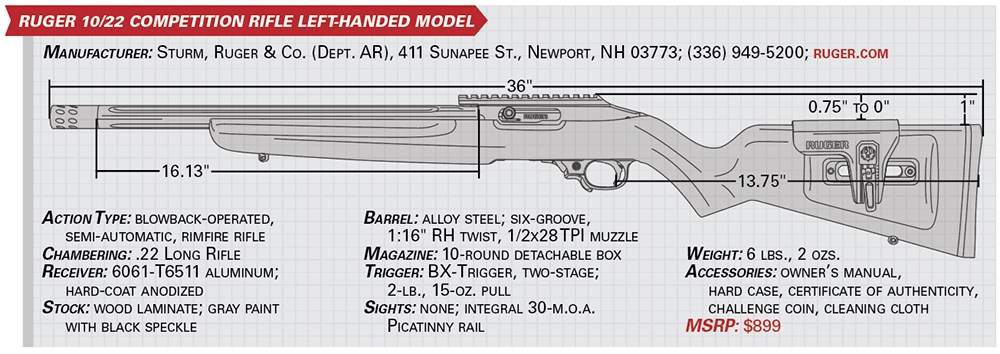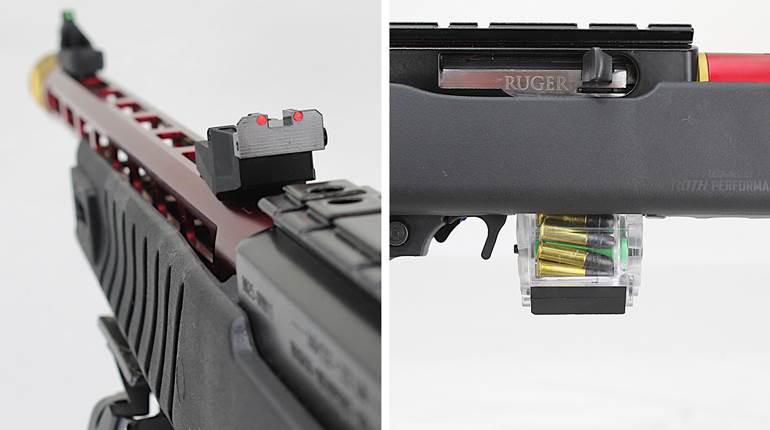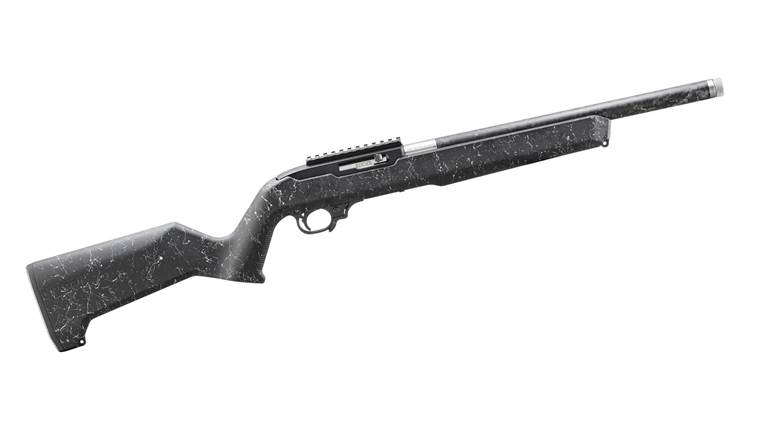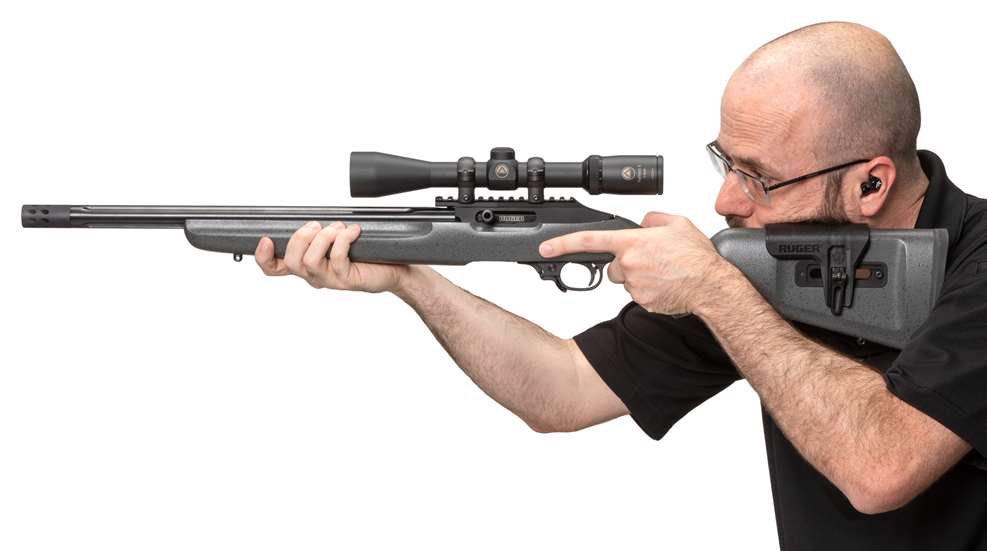
It may have taken 57 years, close to 1,000 model variations and some 8 million units sold, but it looks like Ruger has finally gotten the 10/22 right. I kid, of course; the company’s self-loading rimfire has long been lauded for its reliability, modularity and value, becoming one of the gun industry’s most endearing and enduring rifle designs—for roughly 90 percent of the population, at least. But each and every one that I’ve ever handled over the years has suffered from the same niggling design flaw that needed to be overcome—it’s subtle, but undeniable, right-handedness. Fortunately, at long last, Ruger has decided to address this minor “defect” in what is an otherwise superb platform, and now it’s time for the other 10 percent, myself included, to join in on the fun.
International Left Handers Day may not be a top-tier holiday the likes of Christmas, Easter or Star Wars Day, but southpaw shooters nonetheless got a present this year when Ruger chose this August 13 occasion to unveil its first ever Model 10/22 variant specifically catered toward the left-handed minority. The creatively named 10/22 Competition Rifle Left-Handed Model is a left-ejecting facsimile of the right-hand 10/22 Competition (Model 31120) that was released in 2018 as an inaugural member of Ruger’s Custom Shop, and the new rifle naturally also bears the Custom Shop cartouche atop its receiver.

Rather than truly custom in the traditional sense of the word, for Ruger, the custom shop instead represents the cream of the company’s crop, being populated with heavily refined and richly featured versions of firearms found within the catalog proper. But, while the upgrades made to this gun will undoubtedly be seen as boons to competitors in particular, most are also just good ideas in general, elevating the 10/22 Competition above base-model 10/22s and making it a great all-around rimfire despite its specialist moniker.
The situation may be better than it once was, but lefties definitely still get the short end of the firearm industry’s stick, with most manufacturers giving us only token consideration and many not taking us into account in the slightest. Ruger has always served the southpaw community moderately well (at least in its bolt-action lines—this rifle is the company’s first left-handed semi-automatic of any type), but even it offers my kind far less variety. The product lineup presently lists five Hawkeyes and five centerfire American SKUs set up for left-hand operation, compared to more than 40 and 50 of the rifles, respectively, for righties. And the rimfire situation is even more skewed: Between the seven versions of the Precision Rimfire and the dozens of models of the American Rimfire, right-handed shooters have had upwards of 30 options—lefties have had zero. Until now.
Simply calling the new gun a mirror image of the Model 31120 does something of a disservice to just how much of an undertaking this rifle represents for Ruger. It’s not like the line workers can just go press the “LH” button on the side of the CNC machines to have them start spitting out left-hand guns. Only upon getting my hands on one and taking it apart did it truly become apparent just how many unique left-hand parts had to be manufactured specifically for this model—from the receiver to the barrel and from the stock to the trigger guard assembly—and it shares remarkably few parts with its right-hand brethren. From a production standpoint, this is no mere line extension; it is essentially an entirely new gun.
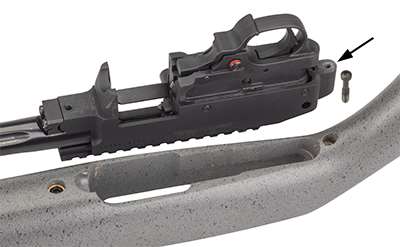
Functionally, the left-hand Competition does not deviate from the 10/22 formula. It is a semi-automatic rifle, chambered in .22 Long Rifle, with a blowback operating system that feeds from a detachable box magazine. Its receiver is machined from heat-treated and stress-relieved 6061 aluminum that is then hard-coat anodized a matte black. Obviously, in order to facilitate left-handed use, the rifle’s ejection port is found on that face of the receiver, with a spring-loaded extractor built into the left side of the bolt and a fixed ejector incorporated into the top, right surface of the trigger module.
The 10/22 Competition’s match bolt is CNC-machined from raw 4140 steel bar stock and then nitride-treated (compared to the standard 10/22’s investment-cast bolt), allowing it to be held to tighter tolerances with its receiver. An enlarged, cylindrical bolt handle allows for on-the-fly, no-look, fumble-free charging of the rifle.
Ruger has cut an integral 13-slot (5.5") Picatinny rail into the top of the receiver that cantilevers slightly out over the barrel, so users won’t need to bother with installing their own base post-purchase in order to mount the optic of their choice. This also eliminates a possible source of scope wobble. Given the potential long-range, competitive applications for which this model is envisioned, this rail segment has also been given a 30-minute-of-angle cant to provide any riflescope mounted atop it additional elevation adjustment when shooting at longer ranges. And employing an optic of some sort is non-optional, as the rifle does not come equipped with a set of back-up irons.
A standard 10/22 receiver affixes to its stock only via a single action screw, with this interface occurring on a tongue found just forward of the magazine well to help stabilize the front of the receiver. In addition to this attachment point, the 10/22 Competition’s receiver also features a rear bedding block fastened to its aft face through which a second action screw is threaded. This additional point of contact with the stock serves to better anchor the back of the receiver, resulting in more consistent bedding and greater shot-to-shot accuracy potential.
Unlike non-Custom Shop models, this rifle features a small hole at the rear of the receiver through which a cleaning rod can be inserted (once the trigger and bolt assemblies have been removed, of course) for breech-to-muzzle maintenance. This is a nice feature given the characteristically dirty nature of rimfire ammunition. Access to this cleaning port, however, does require that the rear bedding block first be removed.

The left-hand 10/22 does require the use of dedicated rotary magazines that load in a clockwise direction—opposite to that of right-hand 10/22 boxes—and I was unable to get the magazines of either type to seat properly within the receivers of the other. One 10-round BX-1 magazine ships with the rifle. In order to differentiate between the otherwise similar magazines, Ruger has provided left-hand magazines with a green internal rotor (instead of a red one), and they are also marked “LH” on both the cap nut and the magazine cap. According to the company, there are no current plans to offer higher-capacity left-hand magazines—such as a southpaw version of the BX-25—but hopefully demand will cause Ruger to re-evaluate this decision at a later time.
The left-hand 10/22 Competition’s cold-hammer-forged alloy-steel bull barrel is 16 1⁄8" long and comes from the factory with a 1¾" radial muzzle brake installed on its 1/2x28 TPI muzzle threads. Like the great majority of Ruger’s .22 LR offerings, its six rifling grooves bear a 1:16" right-handed twist rate. Free-floated its entire length, and measuring a consistent 0.94" in diameter throughout, the barrel features a quartet of 12.75" longitudinal flutes to both help reduce weight and to accelerate heat dissipation by increasing surface area.
In addition to the V-block and two retainer screws found beneath the typical 10/22’s barrel to secure it to the receiver, Competition models also have a third screw centered above the barrel that applies extra upward tension, ensuring that there is no contact between the barrel and its channel in the stock.

For both the southpaw rifle and the Model 31120, Ruger selected laminated wood stocks that are painted gray and then given slight texturing by way of speckled black paint. As good as it may look, I don’t generally love the current trend of using paint flecks in lieu of traditional checkering, but this is a largely moot point when discussing a gun that recoils as minimally as this one. A finger groove extends along the entire length of each side of the fore-end, providing a comfortable ledge for use when shooting offhand, and a pair of metal sling swivels allows for the installation of a sling or an appropriately configured bipod.
Ruger continues to make thorough use of the adjustable-comb system first developed for its RPR, also employing it not only on all but one of the 10/22 Competition models (including this one), but on the Precision Rimfire, and the Long-Range Target variants of the American Rimfire and Hawkeye rifles as well. To adjust either the height of the rifle’s comb or to move it forward or rearward along its slot in the stock, simply unlock the cam lever, maneuver the plastic cheekpiece to the desired location and re-tighten the cam lever.
Crossbolt safeties are generally no friend of southpaws, as they are usually set up exclusively for right-hand use—although a few reversible designs have come out in recent years. This means that the natural, comfortable motion of a righty using his or her trigger finger to push the safety from right to left in order to make the gun ready to fire becomes an unnatural, uncomfortable, pull-to-fire motion when a lefty uses the same gun. Ruger wisely chose a left-for-safe, right-for-fire safety for this 10/22, and it makes a world of difference ergonomically.
Unlike base-model 10/22s, which typically employ a nub of a magazine-release lever that is difficult for many short-fingered shooters to reach while maintaining a firing grip on the rifle, the 10/22 Competition features an upgraded release that extends rearward to hug the contours of the trigger guard assembly. This makes the bilateral control far more accessible, as the user simply needs to straighten the trigger finger and press forward on the release in order to drop a magazine. The rifle also includes an improved bolt lock that permits a locked-open action to be closed with a quick tug on the bolt handle, even on an empty magazine.
Most 10/22s come from Ruger with a serviceable but unextraordinary 6-lb. trigger. Custom Shop 10/22s, however, ship from the company with an upgraded BX-Trigger already installed, and the example present on my test rifle was exceptional—which no doubt helped contribute to the stellar accuracy that the rifle produced during my testing. It broke consistently at around 2 lbs., 15 ozs., of pull—exhibiting about 1/16" of take-up before a clean break with no perceivable overtravel—and its release often took me by surprise in a good way. As far as miscellaneous paraphernalia goes, the 10/22 Competitions also come with several Custom Shop goodies: a hard case, a certificate of authenticity, a challenge coin, a cleaning cloth and a decal.
While I do enjoy crowing about the injustices that southpaws face, after years of predominantly using right-hand firearms by necessity, when I do encounter a lefty gun, it can be disorienting and awkward at first. But this unease quickly dissipates as the advantages of having all the controls in their correct places are experienced, rather than needing to devise the workarounds required by most firearms.
Range time with the southpaw 10/22 was deeply enjoyable, as it functioned 100 percent—which is always something of a minor miracle with any rimfire evaluation—and the experience of having empty cases flung away from my face instead of toward it was a rare treat. Ejection was decidedly forward, with most empties landing at about
11 o’clock of the shooter. Although most strings of fire were taken at a slower, more deliberate pace, the bull barrel resisted any meaningful heating.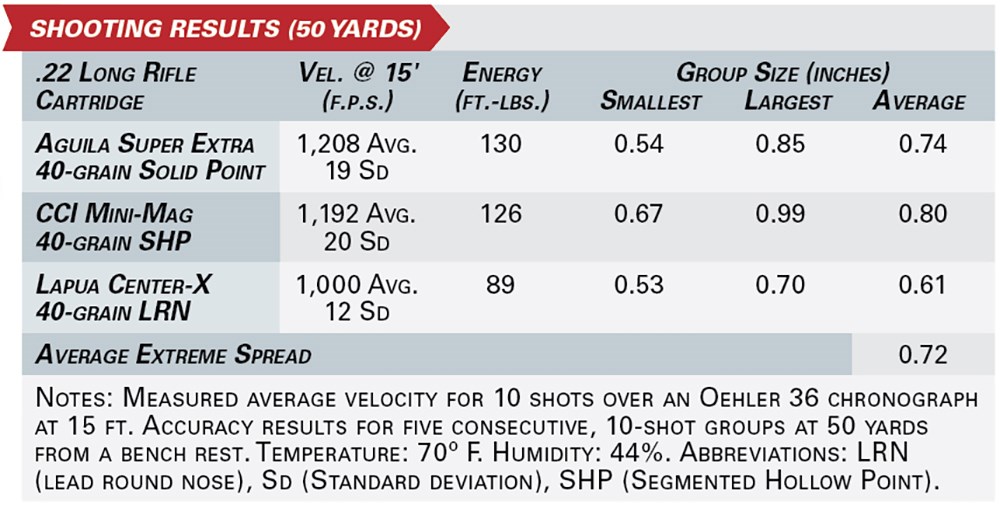
At 6 lbs., 2 ozs., naked, this model is the heaviest 10/22 I could find currently listed on the Ruger website, although it certainly wasn’t too heavy for offhand use or prolonged carry, and its slightly barrel-forward balance gives the rifle a much livelier swing than that of a wispy-barreled carbine. If anything, that extra pound or so makes the already minimal recoil of the .22 LR even more infinitesimal, with the crosshairs of the scope used for accuracy testing barely fidgeting when a shot broke—even at 10X.
As alluded to before, the left-hand 10/22 Competition managed extreme accuracy during its formal testing; I’ve personally never had a semi-automatic perform this well. For a rimfire rifle to excel under American Rifleman’s demanding 10-shot, five-group protocol at 50 yards, both the shooter and the firearm must be acting harmoniously—as was certainly the case here. All three of the 40-grain loads tested grouped very well, producing an excellent 15-group average extreme spread of 0.72", although Lapua’s high-end Center-X load offered both the most consistent accuracy across all five groups (0.61") and the smallest group of the day (0.53"). Center-X’s heavily lubed projectiles certainly did make loading the BX-1 magazines a chore, though.
While some may balk at the 10/22 Competition’s $899 price tag, I’m willing to wager that most of those individuals haven’t spent much time pricing the competition’s boutique 10/22 clones or shopping for premium aftermarket parts. I have several friends who have spent $1,000 or more on tricked-out 10/22 builds, and trying to replicate the performance of the 10/22 Competition for yourself with third-party components of equal quality will almost certainly cost you more than this gun’s real-world price of between $700 and $750. I also give Ruger kudos for setting the new gun’s MSRP as identical to that of the Model 31120, its right-handed doppelganger. There shouldn’t be a surcharge for being a southpaw—a lesson some makers have yet to learn.
At this point, Ruger’s plan is to only offer left-hand 10/22s through its Custom Shop Competition models. But, given that much of the groundwork for a robust line of left-ejecting rifles has already been laid in order to make this first rifle happen, I remain optimistic that additional southpaw 10/22s, including more budget-friendly options, will be forthcoming down the road if this first gun is well-received by lefty shooters. And it absolutely should be.
If I were designing my own ideal rimfire rifle, from the soup to the nuts, it would bear a remarkable resemblance to this gun. Left-handed, obviously. Semi-automatic, suppressor-compatible, adaptable to an extensive assortment of optics and unerringly accurate with an awesome trigger that allows me to make the most of that accuracy? Check, check, check and check.
Listen, for all my belly-aching, I truly do get why left-handed shooters are seemingly an afterthought for most companies. In the zero-sum game of manufacturing, a production line that is used to make a gun that caters to the needs of only 10 percent of the population is a production line not being used to produce something that the vast right-handed majority can use and might be interested in. That is, quite understandably, a decision most companies are unwilling to make. Which is why it’s all the more important for southpaws like myself to reward manufacturers with our patronage when they do take a risk to accommodate us.
Lefties have gotten by using “backward” 10/22s for nearly six decades now, and while the guns aren’t configured in such a way as to make them particularly hard for southpaws to use, that’s hardly the point. For the first time ever, a top-shelf Ruger 10/22 exists that requires zero compromise from left-handed shooters, and I think that’s a pretty big deal. It does, however, beg this question: Can I justify keeping my retrograde, right-hand 10/22 now that it’s doomed to a life gathering dust in the back corner of the safe?